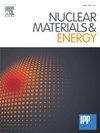Quantum electron dynamics in helium ion injection onto tungsten surfaces based on time-dependent density functional theory
IF 2.3
2区 物理与天体物理
Q1 NUCLEAR SCIENCE & TECHNOLOGY
引用次数: 0
Abstract
The neutralization of an ion particle on a surface is a key issue in plasma–wall interactions. We investigated helium ion injection onto a tungsten surface using time-dependent density functional theory (TDDFT) simulations. We developed the TDDFT code QUMASUN and simulated the process of electron transfer from the surface to the He nucleus by simultaneously solving the time evolution of the electron wavefunction and the classical motion of nuclei. Our results show that the probabilities of changing into and on the surface are approximately 40% and 25%, respectively. The electrons captured by and predominantly occupy the 2s and 2p orbitals, respectively, corresponding to the excited states. In addition, this paper reports the challenges encountered while applying TDDFT to PWI research.
求助全文
约1分钟内获得全文
求助全文
来源期刊

Nuclear Materials and Energy
Materials Science-Materials Science (miscellaneous)
CiteScore
3.70
自引率
15.40%
发文量
175
审稿时长
20 weeks
期刊介绍:
The open-access journal Nuclear Materials and Energy is devoted to the growing field of research for material application in the production of nuclear energy. Nuclear Materials and Energy publishes original research articles of up to 6 pages in length.
 求助内容:
求助内容: 应助结果提醒方式:
应助结果提醒方式:


